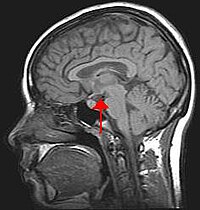
Photo from wikipedia
Brain histamine holds a key position in the regulation of behavioral states, biological rhythms, body weight, energy metabolism, thermoregulation, fluid balance, stress and reproduction in female animals. However, it is… Click to show full abstract
Brain histamine holds a key position in the regulation of behavioral states, biological rhythms, body weight, energy metabolism, thermoregulation, fluid balance, stress and reproduction in female animals. However, it is not clear whether central histamine exerts any effect on hypothalamic-pituitary-testicular in male rats and if so, the involvement of type of central histamine receptors. The current study was designed to determine the effect of centrally administrated histamine on plasma gonadotropin hormone-releasing hormone (GnRH), luteinizing hormone (LH), follicle stimulating hormone (FSH) and testosterone level, and sperm parameters, and to show the mediation of the central histaminergic H1, H2 and H3/H4 receptors on histamine-evoked hormonal and sperm parameters' effects. Studies were performed in male Sprague-Dawley rats. A total of 50 or 100 nmol doses of histamine were injected intracerebroventricularly (icv). 100 nmol dose of histamine significantly caused increases in plasma GnRH, LH, FSH and testosterone levels of animals, but not 50 nmol dose of histamine. Moreover, central pretreatment with chlorpheniramine, histaminergic H1 receptor antagonist (100 nmol), ranitidine and histaminergic H2 receptor antagonist (100 nmol) completely prevented histamine evoked increase in plasma GnRH, LH, FSH and testosterone levels, while thioperamide, histaminergic H3/H4 receptor antagonist (100 nmol) pretreatment failed to reverse sex hormones responses to histamine. Both central histamine treatment alone and central histamine treatment after central histaminergic receptors antagonists' pretreatments did not alter any sperm parameters in rats. In conclusion, our findings show that centrally administered histamine increases plasma GnRH, LH, FSH and testosterone levels of conscious male rats without change any sperm parameters. Moreover, according to our findings, central histaminergic H1, and H2 receptors mediate these histamine-induced effects.
Journal Title: Brain Research
Year Published: 2018
Link to full text (if available)
Share on Social Media: Sign Up to like & get
recommendations!